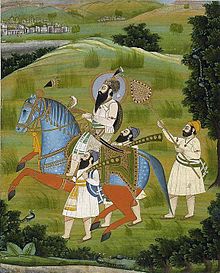 Guru Gobind Singh (Gurmukhi: ਗੁਰੂ ਗੋਬਿੰਦ ਸਿੰਘ) (22 December 1666 – 7 October 1708),[4][5] born Gobind Rai, was the tenth Sikh Guru, a spiritual master, warrior, poet and philosopher. When his father, Guru Tegh Bahadur, was beheaded for refusing to convert to Islam,[6][7] Guru Gobind Singh was formally installed as the leader of the Sikhs at age nine, becoming the tenth Sikh Guru.[8] His four sons died during his lifetime in Mughal-Sikh Wars – two in battle, two executed by the Mughal army.[9][10][11]
Guru Gobind Singh (Gurmukhi: ਗੁਰੂ ਗੋਬਿੰਦ ਸਿੰਘ) (22 December 1666 – 7 October 1708),[4][5] born Gobind Rai, was the tenth Sikh Guru, a spiritual master, warrior, poet and philosopher. When his father, Guru Tegh Bahadur, was beheaded for refusing to convert to Islam,[6][7] Guru Gobind Singh was formally installed as the leader of the Sikhs at age nine, becoming the tenth Sikh Guru.[8] His four sons died during his lifetime in Mughal-Sikh Wars – two in battle, two executed by the Mughal army.[9][10][11]
Among his notable contributions to Sikhism are founding the Sikh warrior community called Khalsa in 1699[1][12][13] and introducing the Five Ks, the five articles of faith that Khalsa Sikhs wear at all times. Guru Gobind Singh also continued the formalisation of the religion, wrote important Sikh texts,[14][15] and enshrined the scripture the Guru Granth Sahib as Sikhism's eternal Guru.[16]
Family and early life
Gobind Singh was the only son of Guru Tegh Bahadur, the ninth Sikh guru, and Mata Gujri. He was born in Patna, Bihar in the Sodhi Khatri family [17] while his father was visiting Bengal and Assam.[4] His birth name was Gobind Rai, and a shrine named Takht Sri Patna Harimandar Sahib marks the site of the house where he was born and spent the first four years of his life.[4] In 1670, his family returned to Punjab, and in March 1672 they moved to Chakk Nanaki in the Himalayan foothills of north India, called the Sivalik range, where he was schooled.[4][12] Gobind Singh's father Tegh Bahadur founded the city of Chakk Nanaki, now known as Anandpur Sahib, in 1665, on land purchased from the ruler of Bilaspur (Kahlur).[citation needed]
His father Guru Tegh Bahadur was petitioned by Kashmiri Pandits[18] in 1675 for protection from the fanatic persecution by Iftikar Khan, an Islamic satrap of the Mughal Emperor Aurangzeb.[4] Tegh Bahadur considered a peaceful resolution by meeting Aurangzeb, but was cautioned by his advisors that his life may be at risk. The young Gobind Rai – to be known as Gobind Singh after 1699[5] – advised his father that no one was more worthy to lead and make a sacrifice than him.[4] His father made the attempt, but was arrested then publicly beheaded in Delhi on 11 November 1675 under the orders of Aurangzeb for refusing to convert to Islam and the ongoing conflicts between Sikhism and the Islamic Empire.[19][20] After this martyrdom, the young Gobind Rai was installed by the Sikhs as the tenth Sikh Guru on Vaisakhi on 29 March 1676.[21]
The education of Guru Gobind Singh continued after he became the 10th Guru, both in reading and writing as well as martial arts such as horse riding and archery. In 1684, he wrote the Chandi di Var in Punjabi language – a legendary war between the good and the evil, where the good stands up against injustice and tyranny, as described in the ancient Sanskrit text Markandeya Purana.[4] He stayed in Paonta, near the banks of river Yamuna, till 1685.[4]
- at age 10, he married Mata Jito on 21 June 1677 at Basantgaṛh, 10 km north of Anandpur. The couple had three sons: Jujhar Singh (b. 1691), Zorawar Singh (b. 1696) and Fateh Singh (b. 1699).[23]
- at age 17, he married Mata Sundari on 4 April 1684 at Anandpur. The couple had one son, Ajit Singh (b. 1687).[24]
- at age 33, he married Mata Sahib Devan on 15 April 1700 at Anandpur. They had no children, but she had an influential role in Sikhism. Guru Gobind Singh proclaimed her as the Mother of the Khalsa.[25]
The life example and leadership of Guru Gobind Singh has been of historic importance to the Sikhs. He institutionalized the Khalsa (literally, Pure Ones), which played the key role in protecting the Sikhs long after his death, such as during the nine invasions of Panjab and holy war led by Ahmad Shah Abdali from Afghanistan between 1747 and 1769.[5]

No comments:
Post a Comment